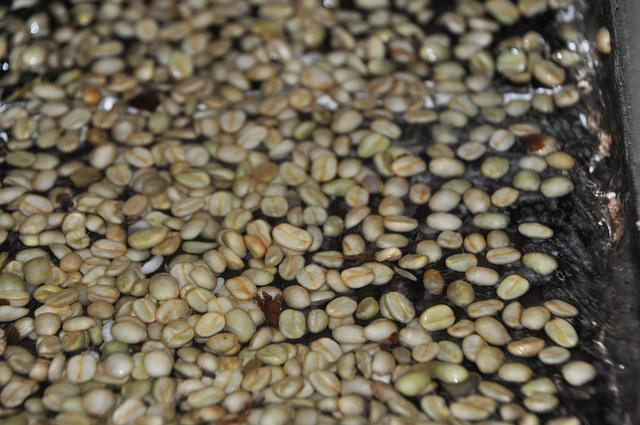Washing green coffee beans before roasting is an important step in the coffee-making process. Not only does it remove any dirt and pulp, but it can also help to improve the flavor of the coffee.
Here are some easy tips for washing green coffee beans:
– Use a colander or strainer to rinse the beans under cold water.
– Soak the beans for 10-15 minutes.
– Rinse the beans thoroughly under running water to remove any residue.
– Pat dry with an absorbent kitchen towel and let them air dry completely before roasting.
Some coffee roasters argue against washing green coffee beans, as it can potentially remove some of the natural flavors and oils.
Let’s dive deeper into some other aspects of washing green coffee beans before roasting to understand what the side effects can be and why you may want to avoid doing it altogether.
Should You Wash Green Coffee Beans Before Roasting?
You should wash green coffee beans before roasting. Washing the coffee cherries removes the outer shell and any debris that may be on the beans. It is important to remove the outer shell because it can cause bitterness in the coffee.
Green coffee beans are the unroasted seeds of the coffee plant, and they can be found at most specialty coffee shops.
Washing green coffee beans is an important step in the coffee roasting process. It helps to remove the chaff, which is the skin that detaches from the bean during roasting.
Some people wash their coffee beans to remove the chaff to avoid it affecting the taste of their coffee. However, this step may not be necessary as roasting naturally removes the chaff. It is important to ensure that washing is done outdoors or in a manner that prevents chaff from blowing all over the place.
Washing removes essential oils and flavor compounds that contribute to the final taste of the coffee.
What Is the Effect of Washing Green Coffee Beans?
People wash coffee beans before they are roasted in order to remove any dirt or debris that may be clinging to them. In addition, washing also helps to remove some of the natural sugars present on the surface of the beans.
This is important because too much sugar can lead to a burnt flavor when the beans are roasted. As a result, washing green coffee beans is an essential step in the coffee-making process.
However, washing green coffee beans can also have an effect on their natural grassy flavor. In particular, it can affect the acidity of the beans because of the moisture content.
Acidity is one of the key attributes that coffee experts look for when assessing the quality of a coffee, and it is generally agreed that washing coffee beans can decrease the acidity of the final product.
This is because washing the beans removes some of the natural oils that contribute to the bean’s flavor. Some coffee drinkers prefer beans that have been washed, as they find that these coffees have a smoother, more balanced flavor.
Others prefer unwashed beans, as they feel that this results in a more complex and interesting cup of coffee. Ultimately, it comes down to personal preference.
What Is the Shelf Life of Green Coffee Beans Before Roasting?
Green coffee beans have a shelf life of around six months. However, this can vary depending on the storage conditions. For example, beans stored in a cool, dry place will last longer than those stored in a warm, humid environment.
Beans that are ground or roasted have a shorter shelf life of around two weeks. The best way to extend the shelf life of coffee beans is to store them in an airtight container in a cool, dark place.
Roasted beans can also be frozen for up to six months. However, it is important to note that freezing coffee beans will change their flavor. Freezing coffee beans can help to preserve their freshness, but it is not a replacement for proper storage.
When it comes to coffee beans, freshness is key to ensuring a good cup of coffee.
Why Shouldn’t You Wash Green Coffee Beans?
Many people believe that washing green coffee beans is an essential step in the roasting process. However, there are a few reasons why this is actually not the best idea.
First of all, green coffee beans are already quite dry, and washing them can actually make them too wet, and too much moisture can lead to mold growth. Read our guide on how mold can be washed off but will still affect the beans. Moisture plays an important role in the roasting process, and too much or too little can lead to problems.
Another reason why washing green coffee beans is not recommended is that it can actually strip away some of the natural oils that give coffee its flavor. These oils are soluble in water, so they can be easily removed by washing.
Finally, it is simply not necessary to wash green coffee beans in order to roast them. The high heat of the roaster will kill any bacteria or mold that might be present, so there is no need to pre-wash the beans.
Leaving the beans unwashed will result in a better cup of coffee unless they are particularly dirty.
How Does Washing Affect the Coffee Beans Roast?
Coffee beans are roasted to bring out their natural flavors, and the roast is a crucial element in determining the final taste of the coffee.
The green coffee bean is actually the seed of coffee plants, and it is this seed that is roasted to produce coffee.
The roasting process affects the green beans in a number of ways, including changing their color, flavor, and acidity. Washing the beans before roasting can have an impact on these attributes.

When you prepare coffee beans for roasting, it is important to take into account the potential effects of washing on the final product.
Washing coffee beans can decrease the acidity of the coffee, and it can also strip away some of the natural oils that contribute to flavor.
Wet coffee beans can also lead to problems during the roasting process, so it is important to make sure that the beans are completely dry before roasting.
What Is the Difference Between Natural and Washed Green Coffee Beans?
The difference between natural and washed green coffee beans lies in the processing method used to remove the outer layer of the coffee cherry and extract the bean inside.
Natural (also known as dry-processed) coffee beans are dried with the fruit still intact, which imparts a fruity and sometimes fermented flavor to the coffee.
In contrast, washed (or wet-processed) coffee beans are first mechanically pulped to remove the outer layer of fruit, then soaked and agitated in water to remove any remaining pulp before being dried.
This results in a cleaner, brighter taste profile with less fruitiness or fermentation notes.
Final Thoughts
Washing green coffee beans before roasting is a practice that benefits coffee roasters. By removing the pulp on the beans, you can ensure a more consistent roast and avoid any off-flavors or aromas that may arise from any dirt left on the beans.
Washing the beans can help preserve their natural sweetness and acidity, resulting in a more flavorful and balanced cup of coffee.
While it may require a bit more effort and time, washing your green coffee beans is a small step that can make a big difference in the quality of your final product.

